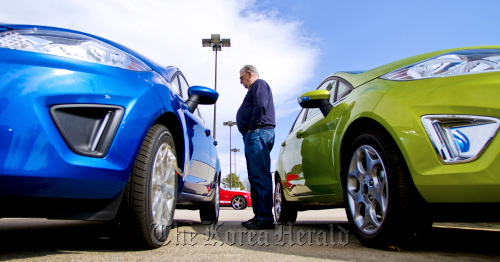Fears that car buyers would stay away from dealerships in August never materialized.
Instead, Americans were lured by new models, cheaper financing and the need to replace aging cars. As a result, August sales rose 7.5 percent compared with the same month last year, according to Autodata Corp.
Most major automakers reported healthy sales increases in August, led by Chrysler with a 31 percent jump. Toyota and Honda saw double-digit declines as they continued to struggle with earthquake-related car shortages.
Results were better than expected. Some analysts thought that the volatile stock market and Hurricane Irene would hurt sales. While it was easy for carmakers to do better than last year, which was the worst August for the industry since a double-dip recession in 1983, the results were also a sign that sales could pick up speed after a disappointing summer of little or no growth.
Instead, Americans were lured by new models, cheaper financing and the need to replace aging cars. As a result, August sales rose 7.5 percent compared with the same month last year, according to Autodata Corp.
Most major automakers reported healthy sales increases in August, led by Chrysler with a 31 percent jump. Toyota and Honda saw double-digit declines as they continued to struggle with earthquake-related car shortages.
Results were better than expected. Some analysts thought that the volatile stock market and Hurricane Irene would hurt sales. While it was easy for carmakers to do better than last year, which was the worst August for the industry since a double-dip recession in 1983, the results were also a sign that sales could pick up speed after a disappointing summer of little or no growth.

“Consumers are inching back into buying items and some big-ticket purchases,” says Paul Ballew, a former GM chief economist who now works for Nationwide Insurance.
He attributed the sales increase to people replacing aging vehicles, record-low loan rates of less than 4 percent for customers with good credit, and high trade-in values for used cars. Car loans carried more than 6 percent interest just three years ago.
People are also driving their cars longer than before the recession. The average age of a car in the U.S. was almost 11 years in July, according to the Polk research firm.
If sales stayed at August’s pace, they would end the year at 12.1 million. That’s better than the 11.6 million last year, but still far below the 17 million in 2005.
Because they have cut staff and factories since the recession, automakers are turning profits at the lower sales levels. But they’re still hoping for a better autumn, as supplies of Japanese cars get back to normal and new cars such as the redesigned Toyota Camry go on sale.
Even Irene could boost sales, as people whose cars were damaged or destroyed look for new ones.
Jesse Toprak, vice president of industry trends and insights for the car pricing site TrueCar.com, says the hurricane cost automakers about 5,000 sales in the last weekend of August, but he expects them to be made up later. GM says it will offer $500 to car buyers in major disaster areas and let those buyers defer payments for 90 days.
Chrysler Group’s sales jump was due to strong demand for Jeeps and minivans. General Motors Co.’s sales rose 18 percent, led by the new Chevrolet Cruze small car, which accounted for one in every 10 GM vehicles sold. Buyers also went for the Chevrolet Equinox and GMC Terrain small crossovers.
New models also boosted Ford Motor Co.’s sales, which rose 11 percent on the strength of the Ford Explorer SUV and Ford Fiesta subcompact.
But Toyota Motor Corp.’s sales fell almost 13 percent, while Honda Motor Co.’s sales slid 24 percent. Dealers are still short on many top-selling models such as the Honda Civic.
Randy Pflughaupt, Toyota’s vice president of sales administration, says all of Toyota’s North American plants will be fully operational this month and will crank up production with overtime and extra shifts. But supplies won’t be completely back to normal levels until next year.
The industry remains wary. The unemployment rate is stuck at 9 percent, food and clothing costs are going up and consumer confidence dropped to its lowest level in more than two years in August. But August sales indicated things are on the right track, barring further bad economic news.
“Consumers are being cautious, yes, and appropriately so, but they are not retrenching,” says GM’s U.S. sales chief Don Johnson. “All indications to us are that the industry is going to continue to slowly grow through the rest of the year.”
(AP)




![[Herald Interview] 'Amid aging population, Korea to invite more young professionals from overseas'](http://res.heraldm.com/phpwas/restmb_idxmake.php?idx=644&simg=/content/image/2024/04/24/20240424050844_0.jpg&u=20240424200058)







![[Hello India] Hyundai Motor vows to boost 'clean mobility' in India](http://res.heraldm.com/phpwas/restmb_idxmake.php?idx=644&simg=/content/image/2024/04/25/20240425050672_0.jpg&u=)






![[Today’s K-pop] NewJeans' single teasers release amid intrigue](http://res.heraldm.com/phpwas/restmb_idxmake.php?idx=642&simg=/content/image/2024/04/26/20240426050575_0.jpg&u=)